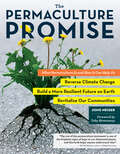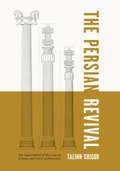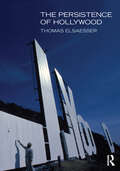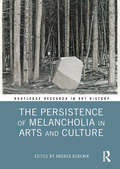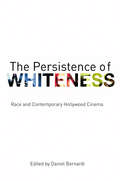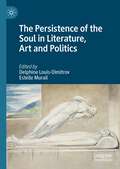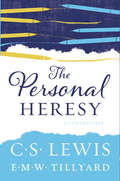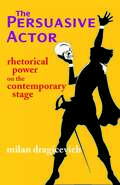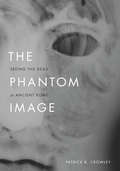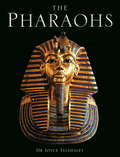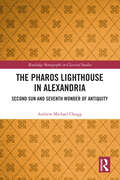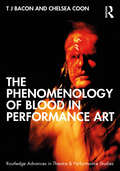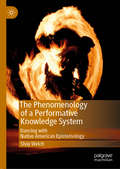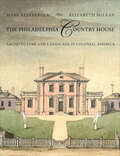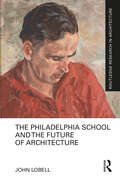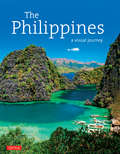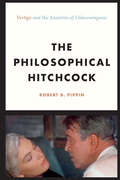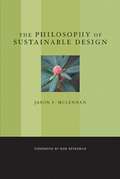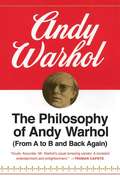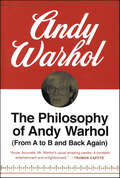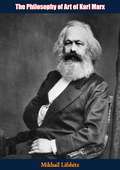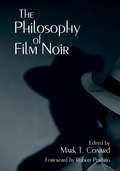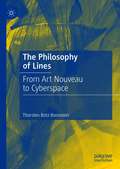- Table View
- List View
The Permaculture Promise: What Permaculture Is and How It Can Help Us Reverse Climate Change, Build a More Resilient Future on Earth, and Revitalize Our Communities
by Toby Hemenway Jono NeigerPermaculture is a sustainability buzzword, but many people wonder what it actually means and why it is relevant. Originally coined by combining the words permanent and agriculture, permaculture has evolved into an optimistic approach connecting all the systems of human life: gardening, housing, transportation, energy, and how we structure our communities. The Permaculture Promise explains in simple terms why permaculture may be the key to unlocking a livable future on our planet. Author Jono Neiger asserts that humans can thrive while simultaneously making Earth healthier and not destroying it. The book shows 22 ways that permaculture can create a better future for all living things. Profiles of people and communities — including an urban dweller who tore up her driveway to create a vegetable garden and a California housing development that dedicates a third of its land to parks, orchards, and gardens — will inspire you to incorporate permaculture principles into your life today.
The Persian Revival: The Imperialism of the Copy in Iranian and Parsi Architecture
by Talinn GrigorOne of the most heated scholarly controversies of the early twentieth century, the Orient-or-Rome debate turned on whether art historians should trace the origin of all Western—and especially Gothic—architecture to Roman ingenuity or to the Indo-Germanic Geist. Focusing on the discourses around this debate, Talinn Grigor considers the Persian Revival movement in light of imperial strategies of power and identity in British India and in Qajar-Pahlavi Iran.The Persian Revival examines Europe’s discovery of ancient Iran, first in literature and then in art history. Tracing Western visual discourse about ancient Iran from 1699 on, Grigor parses the invention and use of a revivalist architectural style from the Afsharid and Zand successors to the Safavid throne and the rise of the Parsi industrialists as cosmopolitan subjects of British India. Drawing on a wide range of Persian revival narratives bound to architectural history, Grigor foregrounds the complexities and magnitude of artistic appropriations of Western art history in order to grapple with colonial ambivalence and imperial aspirations. She argues that while Western imperialism was instrumental in shaping high art as mercantile-bourgeois ethos, it was also a project that destabilized the hegemony of a Eurocentric historiography of taste.An important reconsideration of the Persian Revival, this book will be of vital interest to art and architectural historians and intellectual historians, particularly those working in the areas of international modernism, Iranian studies, and historiography.
The Persian Revival: The Imperialism of the Copy in Iranian and Parsi Architecture
by Talinn GrigorOne of the most heated scholarly controversies of the early twentieth century, the Orient-or-Rome debate turned on whether art historians should trace the origin of all Western—and especially Gothic—architecture to Roman ingenuity or to the Indo-Germanic Geist. Focusing on the discourses around this debate, Talinn Grigor considers the Persian Revival movement in light of imperial strategies of power and identity in British India and in Qajar-Pahlavi Iran.The Persian Revival examines Europe’s discovery of ancient Iran, first in literature and then in art history. Tracing Western visual discourse about ancient Iran from 1699 on, Grigor parses the invention and use of a revivalist architectural style from the Afsharid and Zand successors to the Safavid throne and the rise of the Parsi industrialists as cosmopolitan subjects of British India. Drawing on a wide range of Persian revival narratives bound to architectural history, Grigor foregrounds the complexities and magnitude of artistic appropriations of Western art history in order to grapple with colonial ambivalence and imperial aspirations. She argues that while Western imperialism was instrumental in shaping high art as mercantile-bourgeois ethos, it was also a project that destabilized the hegemony of a Eurocentric historiography of taste.An important reconsideration of the Persian Revival, this book will be of vital interest to art and architectural historians and intellectual historians, particularly those working in the areas of international modernism, Iranian studies, and historiography.
The Persistence of Hollywood
by Thomas ElsaesserWhile Hollywood’s success – its persistence – has remained constant for almost one hundred years, the study of its success has undergone significant expansion and transformation. Since the 1960s, Thomas Elsaesser’s research has spearheaded the study of Hollywood, beginning with his classic essays on auteurism and cinephilia, focused around a director’s themes and style, up to his analysis of the "corporate authorship" of contemporary director James Cameron. In between, he has helped to transform film studies by incorporating questions of narrative, genre, desire, ideology and, more recently, Hollywood’s economic-technological infrastructure and its place within global capitalism. The Persistence of Hollywood brings together Elsaesser’s key writings about Hollywood filmmaking. It includes his detailed studies of individual directors (including Minnelli, Fuller, Ray, Hitchcock, Lang, Altman, Kubrick, Coppola, and Cameron), as well as essays charting the shifts from classic to corporate Hollywood by way of the New Hollywood and the resurgence of the blockbuster. The book also presents a history of the different critical-theoretical paradigms central to film studies in its analysis of Hollywood, from auteurism and cinephilia to textual analysis, Marxism, psychoanalysis, and post-industrial analysis.
The Persistence of Melancholia in Arts and Culture (Routledge Research in Art History)
by Andrea BubenikThis book explores the history and continuing relevance of melancholia as an amorphous but richly suggestive theme in literature, music, and visual culture, as well as philosophy and the history of ideas. Inspired by Albrecht Dürer’s engraving Melencolia I (1514)—the first visual representation of artistic melancholy—this volume brings together contributions by scholars from a variety of disciplines. Topics include: Melencolia I and its reception; how melancholia inhabits landscapes, soundscapes, figures and objects; melancholia in medical and psychological contexts; how melancholia both enables and troubles artistic creation; and Sigmund Freud’s essay "Mourning and Melancholia" (1917).
The Persistence of Whiteness: Race and Contemporary Hollywood Cinema
by Daniel BernardiThe Persistence of Whiteness investigates the representation and narration of race in contemporary Hollywood cinema. Ideologies of class, ethnicity, gender, nation and sexuality are central concerns as are the growth of the business of filmmaking. Focusing on representations of Black, Asian, Jewish, Latina/o and Native Americans identities, this collection also shows how whiteness is a fact everywhere in contemporary Hollywood cinema, crossing audiences, authors, genres, studios and styles. Bringing together essays from respected film scholars, the collection covers a wide range of important films, including Guess Who’s Coming to Dinner, The Color Purple, Star Wars and The Lord of the Rings. Essays also consider genres from the western to blaxploitation and new black cinema; provocative filmmakers such as Melvin Van Peebles and Steven Spielberg and stars including Whoopi Goldberg and Jennifer Lopez. Daniel Bernardi provides an in-depth introduction, comprehensive bibliography and a helpful glossary of terms, thus providing students with an accessible and topical collection on race and ethnicity in contemporary cinema.
The Persistence of the Soul in Literature, Art and Politics
by Estelle Murail Delphine Louis-DimitrovThis book analyses the evolution of literary and artistic representations of the soul, exploring its development through different time periods. The volume combines literary, aesthetic, ethical, and political considerations of the soul in texts and works of art from the seventeenth to the twenty-first centuries, spanning cultures and schools of thought. Drawing on philosophical, religious and psychological theories of the soul, it emphasizes the far-reaching and enduring epistemological function of the concept in literature, art and politics. The authors argue that the concept of the soul has shaped the understanding of human life and persistently irrigated cultural productions. They show how the concept of soul was explored and redefined by writers and artists, remaining relevant even as it became removed from its ancient or Christian origins.
The Personal Heresy: A Controversy
by C. S. Lewis E.M.W. TillyardA repackaged edition of the revered author’s set of dueling critical essays with fellow scholar E. M. W. Tillyard in which they debate the role of an author’s biography in the critical appraisal of literature.C. S. Lewis—the great British writer, scholar, lay theologian, broadcaster, Christian apologist, and bestselling author of Mere Christianity, The Screwtape Letters, The Great Divorce, The Chronicles of Narnia, and many other beloved classics—challenges fellow scholar E. M. W. Tillyard on one of the most intriguing questions involving writers and writing. Is a work of imaginative literature primarily influenced by the author or by the subject matter? Lewis argues that the author’s own personality and biography has little to no impact on the writing, while Tillyard contends the opposite: that the author’s own imagination and story have an indelible influence on a piece of work. Clever, erudite, and enlightening, their debate may not definitively settle the issue, but it does offer invaluable insight and intellectual delight for all dedicated readers.
The Persuasive Actor: Rhetorical Power on the Contemporary Stage
by Milan Dragicevich"A must-have for all actors who encounter speeches that are longer than three sentences. On the surface, that would be classic works from Sophocles through Shakespeare—with the 17th and 18th centuries thrown in. Dig deeper and the book’s value to actors of modern and contemporary drama is inescapable. Ibsen, Shaw, Williams, Miller, Shepard, Wilson, Kushner, and Suzan-Lori Parks all wrote plays that are filled with powerful rhetorical devices that demand lively, thorough, and specific consideration. This book is a guide that unfolds the mysteries of classical rhetoric in a clear, concise, and effective manner, a book for speakers who want to move their audiences. It is aimed at actors, but also belongs on the shelf of lawyers, advertising copywriters, and, of course, public officials. I will use it in my classes and workshops and enthusiastically recommended it to all actors and actor trainers." —Leslie Reidel, Department of Theatre, University of Delaware
The Phantom Image: Seeing the Dead in Ancient Rome
by Patrick R. CrowleyDrawing from a rich corpus of art works, including sarcophagi, tomb paintings, and floor mosaics, Patrick R. Crowley investigates how something as insubstantial as a ghost could be made visible through the material grit of stone and paint. In this fresh and wide-ranging study, he uses the figure of the ghost to offer a new understanding of the status of the image in Roman art and visual culture. Tracing the shifting practices and debates in antiquity about the nature of vision and representation, Crowley shows how images of ghosts make visible structures of beholding and strategies of depiction. Yet the figure of the ghost simultaneously contributes to a broader conceptual history that accounts for how modalities of belief emerged and developed in antiquity. Neither illustrations of ancient beliefs in ghosts nor depictions of afterlife, these images show us something about the visual event of seeing itself. The Phantom Image offers essential insight into ancient art, visual culture, and the history of the image.
The Pharaohs
by Doctor Joyce Tyldesley'Concerning Egypt itself, I shall extend my remarks to a great length, because there is no country that possesses so many wonders.' The Greek writer Herodotus wrote these words as long ago as the 5th century BC, and the ancient civilization of Egypt has continued to cast its spell on historians, archaeologists and visitors ever since. Thanks to its geographical isolation, Egypt developed a unique and self-contained culture whose religion, customs, art, architecture and social structures changed little over 3000 years. And its dry climate led to the preservation of a wealth of monuments including ancient cities, pyramids, temples and other sumptuous artefacts. The Pharaohs is an illustrated history of the kings who ruled over this extraordinary land, narrating the story of 30 dynasties starting around 3100 BC when the first pharaoh, Menes, unified Upper and Lower Egypt, and ending with the conquest of Egypt in 332 BC by Alexander the Great. It profiles powerful, and sometimes enigmatic, rulers such as Mentuhotep II, Thutmose III, Amenophis II, Akhenaten, Tutankhamun and Ramesses II. The story of these kings includes such seminal events in ancient Egyptian history as the development of the science of writing and the building of the first pyramid at Saqqara during the Archaic Period; the building of the pyramids at Giza by the centralized administration of the Old Kingdom; the expansion of trade with the Levant and Nubia during the Middle Kingdom (the 'classical' phase of pharaonic civilization); the rule of the foreign Hyksos kings and their introduction of technical innovations such as the horse-drawn chariot; the undertaking of grandiose building projects in the Valley of the Kings by the pharaohs of New Kingdom; expansion into Palestine and Syria which led to conflict with the Hittites; the long decline of Egypt during the Late Period, culminating in its invasion and annexation by Persia and its eventual conquest by Alexander the Great.
The Pharos Lighthouse In Alexandria: Second Sun and Seventh Wonder of Antiquity (Routledge Monographs in Classical Studies)
by Andrew Michael ChuggThis comprehensive and insightful book brings scientific rigor to the problems of reconstructing the Pharos Lighthouse, one of the Seven Wonders of the Ancient World, and understanding how it functioned as the archetypal lighthouse in antiquity, when it was described as a “second Sun”.Conceived by Alexander the Great and designed by Sostratus, the Pharos lighthouse stood as an iconic landmark of Alexandria for sixteen centuries until felled by a calamitous earthquake in the fourteenth century. The study of this great lighthouse has been neglected relative to other ancient Wonders such as the Great Pyramid of Giza. This book reconstructs the tower, its lustrous light, stunning statues and astounding story in diligent detail through archaeological evidence and surviving antique texts and images, providing a fresh evaluation of the Pharos, its history, and its legacy. The Roman writer Achilles Tatius termed the Pharos a “second Sun”; this expression is explained and explored here for the first time, and has dramatic implications for the nature of the Pharos’ light. The volume also explores how the creation of the Pharos was a key stimulus for Alexandrian science and astronomy in antiquity.The Pharos Lighthouse in Alexandria provides a fascinating new study of this monument of interest to students and scholars of Hellenistic art, architecture, and science, and readers seeking to learn more about one of the Seven Wonders of the Ancient World.
The Phenomenology of Blood in Performance Art (Routledge Advances in Theatre & Performance Studies)
by T. J. Bacon Chelsea CoonThe Phenomenology of Blood in Performance Art is a major new publication that expands the philosophical contextualisation of blood, its presence and absence, across the practice of performance art from a phenomenological perspective.Edited by T. J. Bacon (she/they) and Chelsea Coon (she/her), this book moves through an established cannon of artists and beyond to ensure an inclusive representation of practices from a wider range of practitioners. First-hand interviews and conversations have been gathered from both canonical names as well as individuals who are prevalent in their communities and/or respective subcultures, but less represented within the frameworks of scholarly discourse. Each offers the opportunity to examine their experiences creating artworks and in turn contributes to the context of phenomenological examination within this publication through complementary scholarly texts from leading thinkers who frame phenomenological application to both visual art and transdisciplinary context. Featuring artists through new exclusive interviews and contributions including Marina Abramović, Jelili Atiku, Ron Athey, Franko B, Niya B, Marisa Carnesky, Chelsea Coon, Victor Martinez Diaz, Rufus Elliot, Ernst Fischer, Louis Fleischauer, Poppy Jackson, Mirabelle Jones, Andrei Molodkin, Hermann Nitsch, ORLAN, Mike Parr, Greta Sharp, tjb and Paola Paz Yee, and reference to many more. Alongside new scholarly insight by leading phenomenological and interdisciplinary art scholars and philosophers including T. J. Bacon, Chelsea Coon, Stuart Grant, Kelly Jordan, Lynn Lu, Roberta Mock, Amber Musser and Raegan Truax. Together they represent a significant exploration of intricate and dynamic responses to the cultural fabric of contemporary lived experiences across space and time through the medium of blood in performance art.This incredible analysis of this performance art will be of huge interest to students and practitioners of live art, performance art, phenomenology, and performance philosophy.
The Phenomenology of a Performative Knowledge System: Dancing with Native American Epistemology (Performance Philosophy)
by Shay WelchThis book investigates the phenomenological ways that dance choreographing and dance performance exemplify both Truth and meaning-making within Native American epistemology, from an analytic philosophical perspective. Given that within Native American communities dance is regarded both as an integral cultural conduit and “a doorway to a powerful wisdom,” Shay Welch argues that dance and dancing can both create and communicate knowledge. She explains that dance—as a form of oral, narrative storytelling—has the power to communicate knowledge of beliefs and histories, and that dance is a form of embodied narrative storytelling. Welch provides analytic clarity on how this happens, what conditions are required for it to succeed, and how dance can satisfy the relational and ethical facets of Native epistemology.
The Philadelphia Country House: Architecture and Landscape in Colonial America
by Elizabeth McLean Mark E. ReinbergerA highly readable, beautifully illustrated study of the homes built by elite colonial Philadelphians as retreats—which balanced English models with developing local taste.Colonial Americans, if they could afford it, liked to emulate the fashions of London and the style and manners of English country society while at the same time thinking of themselves as distinctly American. The houses they built reflected this ongoing cultural tension. By the mid-eighteenth century, Americans had developed their own version of the bourgeois English countryseat, a class of estate equally distinct in social function and form from townhouses, rural plantations, and farms. The metropolis of Philadelphia was surrounded by a particularly extraordinary collection of country houses and landscapes. Taken together, these estates make up one of the most significant groups of homes in colonial America.In this masterly volume, Mark Reinberger, a senior architectural historian, and Elizabeth McLean, an accomplished scholar of landscape history, examine the country houses that the urban gentry built on the outskirts of Philadelphia in response to both local and international economic forces, social imperatives, and fashion. What do these structures and their gardens say about the taste of the people who conceived and executed them? How did their evolving forms demonstrate the persistence of European templates while embodying the spirit of American adaptation?The Philadelphia Country House explores the myriad ways in which these estates—which were located in the country but responded to the ideas and manners of the city—straddled the cultural divide between urban and rural. Moving from general trends and building principles to architectural interiors and landscape design, Reinberger and McLean take readers on an intimate tour of the fine, fashionable elements found in upstairs parlors and formal gardens. They also reveal the intricate working world of servants, cellars, and kitchen gardens. Highlighting an important aspect of American historic architecture, this handsome volume is illustrated with nearly 150 photographs, more than 60 line drawings, and two color galleries.
The Philadelphia School and the Future of Architecture (Routledge Research in Architecture)
by John LobellFlourishing from 1951 to 1965, the Philadelphia School was an architectural golden age that saw a unique convergence of city, practice, and education, all in renewal. And it was a bringing together of architecture, city and regional planning, and landscape architecture education under the leadership of Dean G. Holmes Perkins. During that time at the architecture school at the University of Pennsylvania (known as the Graduate School of Fine Arts or GSFA), Louis Kahn and Robert Venturi were transforming modern architecture; Romaldo Giurgola was applying continental philosophy to architectural theory; Robert Le Ricolais was building experimental structures; Ian McHarg was questioning Western civilization and advancing urban and regional ecology; Herbert Gans was moving into Levittown; and Denise Scott Brown was forging a syncretism of European and American planning theory and discovering popular culture. And in the city, Edmund Bacon was directing the most active city planning commission in the country. This book describes the history of the school, the transformation of the city of Philadelphia, and the philosophy of the Philadelphia School in the context of other movements of the time, and looks at what the Philadelphia School has to offer to architecture today and in the future, all from the point of view of a student who was there.
The Philippines: A Visual Journey
by Elizabeth V. ReyesThis beautifully photographed travel pictorial captures the people, art, architecture, food and landscapes of the Philippines.The Philippine Archipelago with its 7,100 islands is culturally diverse and unique in Southeast Asia, and renowned for the splendor of its coastal beaches and terraced mountains. Seventy million Filipinos have been nurtured by both tropical environment and unique historical development-through 300 years of Spanish Chistianization and 40 years of American modernization-and have emerged as an attractive blend of East and West, soul and style. The island country is perhaps best known for the friendliness of its people and their natural sense of song, dance and hospitality. The archipelago is also called "Pearl of the Orient".With over 150 photographs and a detailed map, The Philippines: A Visual Journey is an essential book for expats or tourists traveling to the Philippines.
The Philosophical Hitchcock: “Vertigo” and the Anxieties of Unknowingness
by Robert B. PippinOn the surface, The Philosophical Hitchcock: Vertigo and the Anxieties of Unknowingness, is a close reading of Alfred Hitchcock’s 1958 masterpiece Vertigo. This, however, is a book by Robert B. Pippin, one of our most penetrating and creative philosophers, and so it is also much more. Even as he provides detailed readings of each scene in the film, and its story of obsession and fantasy, Pippin reflects more broadly on the modern world depicted in Hitchcock’s films. Hitchcock’s characters, Pippin shows us, repeatedly face problems and dangers rooted in our general failure to understand others—or even ourselves—very well, or to make effective use of what little we do understand. Vertigo, with its impersonations, deceptions, and fantasies, embodies a general, common struggle for mutual understanding in the late modern social world of ever more complex dependencies. By treating this problem through a filmed fictional narrative, rather than discursively, Pippin argues, Hitchcock is able to help us see the systematic and deep mutual misunderstanding and self-deceit that we are subject to when we try to establish the knowledge necessary for love, trust, and commitment, and what it might be to live in such a state of unknowingness. A bold, brilliant exploration of one of the most admired works of cinema, The Philosophical Hitchcock will lead philosophers and cinephiles alike to a new appreciation of Vertigo and its meanings.
The Philosophy Of Sustainable Design
by Jason F. MclennanOutlines the major ideas and issues in the movement of green architecture and sustainable design. This book is intended as a starting point for those involved in the building industry. It asks individuals to understand how the philosophy of sustainable design can affect their own work.
The Philosophy of Andy Warhol: From A to B and Back Again
by Andy WarholThe private Andy Warhol talks: about love, sex, food, beauty, fame, work, money, success; about New York and America; and about himself--his childhood in McKeesport, Pennsylvania, good times and bad times in the Big Apple, the explosion of his career in the sixties, and life among celebrities.
The Philosophy of Andy Warhol: From A to B and Back Again
by Andy WarholIn The Philosophy of Andy Warhol, the enigmatic, legendary Warhol makes the reader his confidant on love, sex, food, beauty, fame, work, money, success, and much more.Andy Warhol claimed that he loved being outside a party—so that he could get in. But more often than not, the party was at his own studio, The Factory, where celebrities—from Edie Sedgwick and Allen Ginsberg to the Rolling Stones and the Velvet Underground—gathered in an ongoing bash.A loosely formed autobiography, told with his trademark blend of irony and detachment, this compelling and eccentric memoir riffs and reflects on all things Warhol: New York, America, and his childhood in McKeesport, Pennsylvania, as well as the explosion of his career in the sixties, and his life among the rich and famous.
The Philosophy of Argument and Audience Reception
by Christopher W. TindaleRecent work in argumentation theory has emphasized the nature of arguers and arguments along with various theoretical perspectives. Less attention has been given to the third feature of any argumentative situation - the audience. This book fills that gap by studying audience reception to argumentation and the problems that come to light as a result of this shift in focus. Christopher W. Tindale advances the tacit theories of several earlier thinkers by addressing the central problems connected with audience considerations in argumentation, problems that earlier philosophical theories overlook or inadequately accommodate. The main tools employed in exploring the central issues are drawn from contemporary philosophical research on meaning, testimony, emotion and agency. These are then combined with some of the major insights of recent rhetorical work in argumentation to advance our understanding of audiences and suggest avenues for further research.
The Philosophy of Art of Karl Marx
by Mikhail LifshitzThe Philosophy of Art of Karl Marx, first published in 1933, is one of the major works of the Russian aesthetician and literary critic Mikhail Aleksandrovich Lifshitz. The author and editor of numerous books and articles in Marxist aesthetics, including ‘Marx and Engels on Art’ 1933, and ‘Lenin and Culture and Art’ 1938. Lifshitz has been since 1925 a teacher of philosophy and aesthetics in higher education institutes in Moscow. His writings have ranged from studies of contemporary bourgeois culture to the history of aesthetics and the relations between political commitment and artistic production. Since the war much of his work has concerned itself with modern Russian and European culture.The Philosophy of Art of Karl Marx, is notable for its originality of method in approaching the subject of Marx’s aesthetics. Far from being a mere compendium of Marx’s comments on art and literature, it treats his writing in this field as an integral part of the totality of his thought. In his complex but lucid argument Lifshitz demonstrates the relations between Marx’s changing views of art and the development of his revolutionary theory – ranging from Marx’s own early Romantic poetry to ‘Capital’. In the process the book discusses some of Marx’s comment on art, in notebooks and articles, which are still little known.-Print ed.
The Philosophy of Film Noir (The Philosophy of Popular Culture #Ppcs)
by Mark T. ConardAn essay collection examining the philosophical elements of select films in noir cinema, as well as the genre’s legacy in film and culture.A drifter with no name and no past, driven purely by desire, is convinced by a beautiful woman to murder her husband. A hard-drinking detective down on his luck becomes involved with a gang of criminals in pursuit of a priceless artifact. The stories are at once romantic, pessimistic, filled with anxiety and a sense of alienation, and they define the essence of film noir. Noir emerged as a prominent American film genre in the early 1940s, distinguishable by its use of unusual lighting, sinister plots, mysterious characters, and dark themes. From The Maltese Falcon (1941) to Touch of Evil (1958), films from this classic period reflect an atmosphere of corruption and social decay that attracted such accomplished directors as John Huston, Alfred Hitchcock, Billy Wilder, and Orson Welles.The Philosophy of Film Noir is the first volume to focus exclusively on the philosophical underpinnings of these iconic films. Drawing on the work of diverse thinkers, from the French existentialist Albert Camus to the Frankurt school theorists Max Horkheimer and Theodor Adorno, the volume connects film noir to the philosophical questions of a modern, often nihilistic, world. Opening with an examination of what constitutes noir cinema, the book interprets the philosophical elements consistently present in the films—themes such as moral ambiguity, reason versus passion, and pessimism. The contributors to the volume also argue that the essence and elements of noir have fundamentally influenced movies outside of the traditional noir period. Neo-noir films such as Pulp Fiction (1994), Fight Club (1999), and Memento (2000) have reintroduced the genre to a contemporary audience. As they assess the concepts present in individual films, the contributors also illuminate and explore the philosophical themes that surface in popular culture.A close examination of one of the most significant artistic movements of the twentieth century, The Philosophy of Film Noir reinvigorates an intellectual discussion at the intersection of popular culture and philosophy.Praise for The Philosophy of Film Noir“The essays work both as solid primers into philosophy, stretching from Aristotle to Schopenhauer, and as lucid excursions into the genre’s dark, mean streets. . . . A fascinating, readable, and provocative book. . . . Highly recommended.” —Choice“Dense and intriguing, the book suggests noir is best perceived as a slightly warped mirror held up to contemporary society.” —Publishers Weekly
The Philosophy of Lines: From Art Nouveau to Cyberspace
by Thorsten Botz-BornsteinThis book offers a philosophical exploration of lines in art and culture, and traces their history from Antiquity onwards. Lines can be physical phenomena, cognitive responses to observed processes, or both at the same time. Based on this assumption, the book describes the “philosophy of lines” in art, architecture, and science. The book compares Western and Eastern traditions. It examines lines in the works of Paul Klee, Wassily Kandinsky, and Henri Michaux, as well as in Chinese and Japanese art and calligraphy. Lines are not merely a matter of aesthetics but also reflect the psychological states of entire cultures. In the nineteenth century, non-Euclidean geometry sparked the phenomenon of the “self-negating line,” which influenced modern art; it also prepared the ground for virtual reality. Straight lines, distorted lines, blurred lines, hot and cold lines, dynamic lines, lines of force, virtual lines, and on and on, lines narrate the development of human civilization.
